王之泰201771010131《面向对象程序设计(java)》第八周学习总结
第一部分:理论知识学习部分
第六章
第六章知识点主要分为1. 接口 2. lambda表达式 3. 内部类 4. 代理
1. 接口
1) Java为了克服单继承的缺点,Java使用了接口, 一个类可以实现一个或多个接口。
2) 在Java程序设计语言中,接口不是类,而是对类 的一组需求描述,由常量和一组抽象方法组成。
3) 接口中不包括变量和有具体实现的方法。
4) 只要类实现了接口,则该类要遵从接口描述的统 一格式进行定义,并且可以在任何需要该接口的 地方使用这个类的对象。
5)声明方式: public interface 接口名 { …… } 接口体中包含常量定义和方法定义,接口中只进 行方法的声明,不提供方法的实现。
6)类似建立类的继承关系,接口也可以扩展。 接口的扩展技术使得从具有较高通用性的接口存在 多条链延伸到具有较高专用性的接口。
扩展方法: public interface 接口1 extends接口2 { …… }
7)在类声明时用implements关键字声明使用一个或 多个接口
class Employee implementsPrintable { …… }
一个类使用了某个接口,那么这个类必须实现该 接口的所有方法,即为这些方法提供方法体。 一个类可以实现多个接口,接口间应该用逗号分 隔开。
class Employee implements Cloneable,Comparable
8)接口不能构造接口对象,但可以声明接口变量以指向一个实现了该接口的类对象。
Comparablex = new Comparable(…); //ERROR
Comparable x= new Employee(…); //OK
可以用instanceof检查对象是否实现了某个接口。
if (anObjectinstanceofComparable) { ……}
2. 接口与抽象类的区别: (1)接口不能实现任何方法,而抽象类可以。 (2)类可以实现许多接口,但只有一个父类。 (3)接口不是类分级结构的一部分,无任何联系的类可以实现相同的接口。
3. 回调(callback):一种程序设计模式,在这种模式中,可指出某个特定事件发生时程序应该采取的动作。 在java.swing包中有一个Timer类,可以使用它在到达给定的时间间隔时触发一个事件。
Timer(intinterval, ActionListenerlistener)
void start()
void stop()
4. Object类的Clone方法
1)当拷贝一个对象变量时,原始变量与拷贝变量引用同一个对象。这样,改变一个变量所引用 的对象会对另一个变量产生影响。
2)如果要创建一个对象新的copy,它的最初状态与 original一样,但以后可以各自改变状态,就需要使用Object类的clone方法。
5. 浅层拷贝:被拷贝对象的所有常量成员和基本类 型属性都有与原来对象相同的拷贝值,而若成员域是一个对象,则被拷贝对象该对象域的对象引 用仍然指向原来的对象。
深层拷贝:被拷贝对象的所有成员域都含有与原 来对象相同的值,且对象域将指向被复制过的新对 象,而不是原有对象被引用的对象。换言之,深 层拷贝将拷贝对象内引用的对象也拷贝一遍。
6. Java Lambda 表达式是Java 8 引入的一个新的功能,主要用途是提供一个函数化的语法来简化编码。 Lambda表达式本质上是一个匿名方法。
public intadd(intx, inty) { return x + y; } 转成Lambda表达式后是: (intx, inty) -> x + y;
7.内部类(inner class)是定义在一个类内部的类。 外层的类成为外部类(outer class).
内部类主要用于事件处理。 使用内部类的原因有以下三个:
1)内部类方法可以访问该类定义所在的作用域中的数据,包括私有数据。
2)内部类能够隐藏起来,不为同一包中的其他类所见。
3)想要定义一个回调函数且不想编写大量代码时, 使用匿名内部类比较便捷。
第二部分:实验部分 — 接口的定义与使用
实验时间 2018-10-18
1、实验目的与要求
(1) 掌握接口定义方法;
(2) 掌握实现接口类的定义要求;
(3) 掌握实现了接口类的使用要求;
(4) 掌握程序回调设计模式;
(5) 掌握Comparator接口用法;
(6) 掌握对象浅层拷贝与深层拷贝方法;
(7) 掌握Lambda表达式语法;
(8) 了解内部类的用途及语法要求。
2、实验内容和步骤
实验1: 导入第6章示例程序,测试程序并进行代码注释。
测试程序1:
1.编辑、编译、调试运行阅读教材214页-215页程序6-1、6-2,理解程序并分析程序运行结果;
2.在程序中相关代码处添加新知识的注释。
3,掌握接口的实现用法;
4.掌握内置接口Compareable的用法。
EmployeeSortTest程序
package interfaces; import java.util.*; /**
* This program demonstrates the use of the Comparable interface.
* @version 1.30 2004-02-27
* @author Cay Horstmann
*/
public class EmployeeSortTest
{
public static void main(String[] args)
{
Employee[] staff = new Employee[3]; staff[0] = new Employee("Harry Hacker", 35000);
staff[1] = new Employee("Carl Cracker", 75000);
staff[2] = new Employee("Tony Tester", 38000); Arrays.sort(staff); // 打印所有员工对象的信息
for (Employee e : staff)
System.out.println("name=" + e.getName() + ",salary=" + e.getSalary());
}
}
Employee程序
package interfaces; //将类声明为实现为某个接口,使用implements关键字
public class Employee implements Comparable<Employee>
{
private String name;
private double salary; public Employee(String name, double salary)
{
this.name = name;
this.salary = salary;
} public String getName()
{
return name;
} public double getSalary()
{
return salary;
} public void raiseSalary(double byPercent)
{
double raise = salary * byPercent / 100;
salary += raise;
} /**
* Compares employees by salary
* @param other another Employee object
* @return a negative value if this employee has a lower salary than
* otherObject, 0 if the salaries are the same, a positive value otherwise
*/
public int compareTo(Employee other)
{
// 这里使用了静态Double.compare方法,且为泛型Comparable提供了一个类型参数
return Double.compare(salary, other.salary);
}
}
实验结果:

测试程序2:
编辑、编译、调试以下程序,结合程序运行结果理解程序
interface A
{
double g=9.8;
void show( );
}
class C implements A
{
public void show( )
{System.out.println("g="+g);}
} class InterfaceTest
{
public static void main(String[ ] args)
{
A a=new C( );
a.show( );
System.out.println("g="+C.g);
}
}
实验结果:

测试程序3:
1.在elipse IDE中调试运行教材223页6-3,结合程序运行结果理解程序;
2.26行、36行代码参阅224页,详细内容涉及教材12章。
3.在程序中相关代码处添加新知识的注释。
4.掌握回调程序设计模式;
6-3代码如下:
/**
@version 1.01 2015-05-12
@author Cay Horstmann
*/ import java.awt.*;
import java.awt.event.*;
import java.util.*;
import javax.swing.*;
import javax.swing.Timer;
// 用JavaUTIL计时器解决冲突 public class TimerTest
{
public static void main(String[] args)
{
ActionListener listener = new TimePrinter(); // 构建一个调用侦听器的计时器
// 每十秒一次
Timer t = new Timer(10000, listener);
t.start(); JOptionPane.showMessageDialog(null, "Quit program?");
System.exit(0);
}
} class TimePrinter implements ActionListener
{
public void actionPerformed(ActionEvent event)
{
System.out.println("At the tone, the time is " + new Date());
Toolkit.getDefaultToolkit().beep();
}
}
实验结果如下:
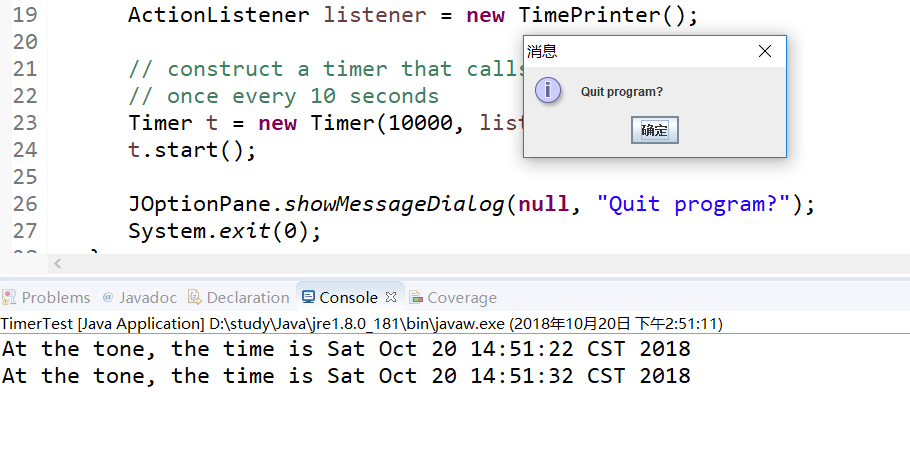
测试程序4:
1.调试运行教材229页-231页程序6-4、6-5,结合程序运行结果理解程序;
2.在程序中相关代码处添加新知识的注释。
3.掌握对象克隆实现技术;
4.掌握浅拷贝和深拷贝的差别。
6-4程序如下:
package clone; /**
* This program demonstrates cloning.
* @version 1.10 2002-07-01
* @author Cay Horstmann
*/
//克隆了employee中的一个实例,调用了两个更改器的方法
public class CloneTest
{
public static void main(String[] args)
{
try
{
Employee original = new Employee("John Q. Public", 50000);
original.setHireDay(2000, 1, 1);
Employee copy = original.clone();
copy.raiseSalary(10);//raiseSalary方法改变salary域的值
copy.setHireDay(2002, 12, 31);//setHireDay改变hireday域的状态
System.out.println("original=" + original);
System.out.println("copy=" + copy);
}
catch (CloneNotSupportedException e)
{
e.printStackTrace();
}
}
}
6-5程序如下:
package clone; import java.util.Date;
import java.util.GregorianCalendar; public class Employee implements Cloneable
{
private String name;
private double salary;
private Date hireDay; public Employee(String name, double salary)
{
this.name = name;
this.salary = salary;
hireDay = new Date();
} public Employee clone() throws CloneNotSupportedException
{
// 调用对象clone
Employee cloned = (Employee) super.clone(); // 克隆可变字段
cloned.hireDay = (Date) hireDay.clone(); return cloned;
} /**
* Set the hire day to a given date.
* @param year the year of the hire day
* @param month the month of the hire day
* @param day the day of the hire day
*/
public void setHireDay(int year, int month, int day)
{
Date newHireDay = new GregorianCalendar(year, month - 1, day).getTime(); // 实例字段突变示例
hireDay.setTime(newHireDay.getTime());
} public void raiseSalary(double byPercent)
{
double raise = salary * byPercent / 100;
salary += raise;
} public String toString()
{
return "Employee[name=" + name + ",salary=" + salary + ",hireDay=" + hireDay + "]";
}
}
实验结果如下:

实验2: 导入第6章示例程序6-6,学习Lambda表达式用法。
1.调试运行教材233页-234页程序6-6,结合程序运行结果理解程序;
2.在程序中相关代码处添加新知识的注释。
将27-29行代码与教材223页程序对比,将27-29行代码与此程序对比,体会Lambda表达式的优点。
6-6程序如下:
package lambda; import java.util.*; import javax.swing.*;
import javax.swing.Timer; /**
* This program demonstrates the use of lambda expressions.
* @version 1.0 2015-05-12
* @author Cay Horstmann
*/
public class LambdaTest
{
public static void main(String[] args)
{
String[] planets = new String[] { "Mercury", "Venus", "Earth", "Mars",
"Jupiter", "Saturn", "Uranus", "Neptune" };
System.out.println(Arrays.toString(planets));
System.out.println("Sorted in dictionary order:");
Arrays.sort(planets);
System.out.println(Arrays.toString(planets));
System.out.println("Sorted by length:");
Arrays.sort(planets, (first, second) //先指定类型,再计算表达式
-> first.length() - second.length());
System.out.println(Arrays.toString(planets)); Timer t = new Timer(1000, event
->System.out.println("The time is " + new Date()));
t.start(); // 保持程序运行直到用户选择“OK”
JOptionPane.showMessageDialog(null, "Quit program?");
System.exit(0);
}
}
实验结果如下:
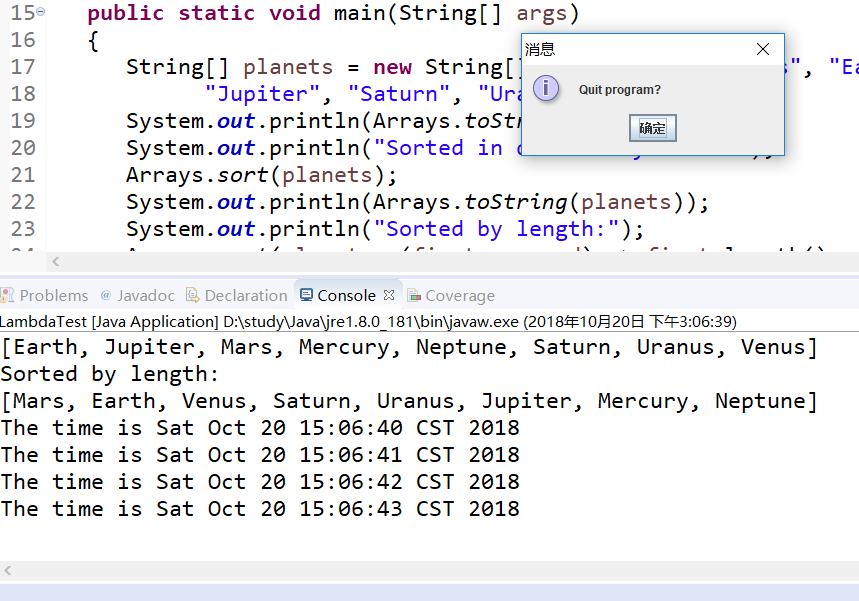
实验3: 编程练习
1.编制一个程序,将身份证号.txt 中的信息读入到内存中;
2.按姓名字典序输出人员信息;
3.查询最大年龄的人员信息;
4.查询最小年龄人员信息;
5.输入你的年龄,查询身份证号.txt中年龄与你最近人的姓名、身份证号、年龄、性别和出生地;
6.查询人员中是否有你的同乡。
实验代码如下:
package IDcard; import java.io.BufferedReader;
import java.io.File;
import java.io.FileInputStream;
import java.io.FileNotFoundException;
import java.io.IOException;
import java.io.InputStreamReader;
import java.util.ArrayList;
import java.util.Scanner;
import java.util.Collections; public class ID { public static People findPeopleByname(String name) {
People flag = null;
for (People people : peoplelist) {
if(people.getName().equals(name)) {
flag = people;
}
}
return flag; } public static People findPeopleByid(String id) {
People flag = null;
for (People people : peoplelist) {
if(people.getnumber().equals(id)) {
flag = people;
}
}
return flag; } private static ArrayList<People> agenear(int yourage) {
// TODO Auto-generated method stub
int j=0,min=53,d_value=0,k = 0;
ArrayList<People> plist = new ArrayList<People>();
for (int i = 0; i < peoplelist.size(); i++) {
d_value = peoplelist.get(i).getage() > yourage ?
peoplelist.get(i).getage() - yourage : yourage - peoplelist.get(i).getage() ;
k = d_value < min ? i : k;
min = d_value < min ? d_value : min;
}
for(People people : peoplelist) {
if(people.getage() == peoplelist.get(k).getage()) {
plist.add(people);
}
}
return plist;
} private static ArrayList<People> peoplelist; public static void main(String[] args) {
peoplelist = new ArrayList<People>();
Scanner scanner = new Scanner(System.in);
File file = new File("D:\\身份证号.txt");
try {
FileInputStream files = new FileInputStream(file);
BufferedReader in = new BufferedReader(new InputStreamReader(files));
String temp = null;
while ((temp = in.readLine()) != null) { String[] information = temp.split("[ ]+");
People people = new People();
people.setName(information[0]);
people.setnumber(information[1]);
int A = Integer.parseInt(information[3]);
people.setage(A);
people.setsex(information[2]);
for(int j = 4; j<information.length;j++) {
people.setplace(information[j]);
}
peoplelist.add(people); }
} catch (FileNotFoundException e) {
System.out.println("文件未找到");
e.printStackTrace();
} catch (IOException e) {
System.out.println("文件读取错误");
e.printStackTrace();
}
boolean isTrue = true;
while (isTrue) { System.out.println("******************************************");
System.out.println(" 1.按姓名典序输出人员信息");
System.out.println(" 2.查询最大年龄人员信息");
System.out.println(" 3.查询最小年龄人员信息");
System.out.println(" 4.输入你的年龄,查询身份证号.txt中年龄与你最近的人");
System.out.println(" 5.查询人员中是否有你的同乡");
System.out.println(" 6.退出");
System.out.println("******************************************");
int nextInt = scanner.nextInt();
switch (nextInt) {
case 1:
Collections.sort(peoplelist);
System.out.println(peoplelist.toString());
break;
case 2:
int max=0;
int j,k1 = 0;
for(int i=1;i<peoplelist.size();i++)
{
j = peoplelist.get(i).getage();
if(j>max)
{
max = j;
k1 = i;
} }
System.out.println("年龄最大:"+peoplelist.get(k1));
break;
case 3:
int min = 100;
int j1,k2 = 0;
for(int i=1;i<peoplelist.size();i++)
{
j1 = peoplelist.get(i).getage();
if(j1<min)
{
min = j1;
k2 = i;
} }
System.out.println("年龄最小:"+peoplelist.get(k2));
break;
case 4:
System.out.println("年龄:");
int input_age = scanner.nextInt();
ArrayList<People> plist = new ArrayList<People>();
plist = agenear(input_age);
for(People people : plist) {
System.out.println(people.toString());
}
break;
case 5:
System.out.println("请输入省份");
String find = scanner.next();
for (int i = 0; i <peoplelist.size(); i++)
{
String [] place = peoplelist.get(i).getplace().split("\t");
for(String temp : place) {
if(find.equals(temp)) {
System.out.println("你的同乡是 "+peoplelist.get(i));
break;
}
} }
break;
case 6:
isTrue = false;
System.out.println("byebye!");
break;
default:
System.out.println("输入有误");
}
}
} }
package IDcard;
public class People implements Comparable<People> {
private String name = null;
private String number = null;
private int age = 0;
private String sex = null;
private String place = null;
public String getName()
{
return name;
}
public void setName(String name)
{
this.name = name;
}
public String getnumber()
{
return number;
}
public void setnumber(String number)
{
this.number = number;
}
public int getage()
{
return age;
}
public void setage(int age )
{
this.age = age;
}
public String getsex()
{
return sex;
}
public void setsex(String sex )
{
this.sex = sex;
}
public String getplace()
{
return place;
}
public void setplace(String place)
{
if(this.place == null) {
this.place = place;
}else {
this.place = this.place+ "\t" +place;
}
}
public int compareTo(People o)
{
return this.name.compareTo(o.getName());
}
public String toString()
{
return name+"\t"+sex+"\t"+age+"\t"+number+"\t"+place+"\n";
}
}
实验结果如下:

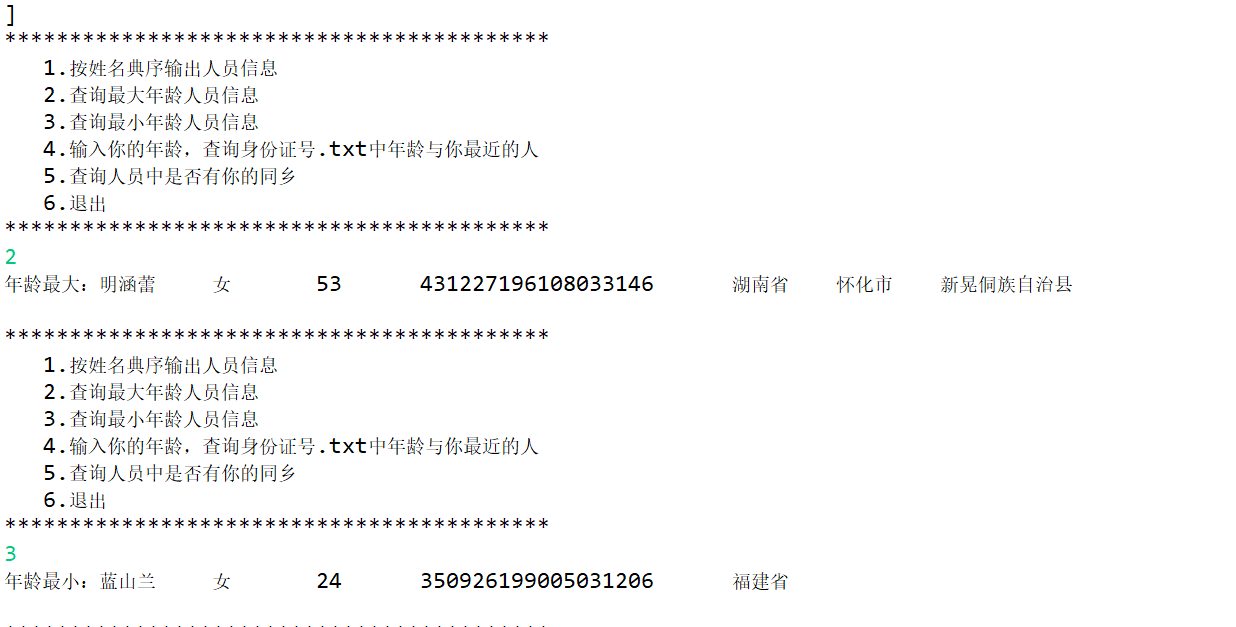


实验4:内部类语法验证实验
实验程序1:
1.编辑、调试运行教材246页-247页程序6-7,结合程序运行结果理解程序;
2.了解内部类的基本用法。
6-7程序如下:
package innerClass; import java.awt.*;
import java.awt.event.*;
import java.util.*;
import javax.swing.*;
import javax.swing.Timer; /**
* This program demonstrates the use of inner classes.
* @version 1.11 2015-05-12
* @author Cay Horstmann
*/
public class InnerClassTest
{
public static void main(String[] args)
{
TalkingClock clock = new TalkingClock(1000, true);
clock.start(); // keep program running until user selects "Ok"
JOptionPane.showMessageDialog(null, "Quit program?");
System.exit(0);
}
} /**
* A clock that prints the time in regular intervals.
*/
class TalkingClock
{
private int interval;
private boolean beep; /**
* Constructs a talking clock
* @param interval the interval between messages (in milliseconds)
* @param beep true if the clock should beep
*/
public TalkingClock(int interval, boolean beep)
{
this.interval = interval;
this.beep = beep;
} /**
* Starts the clock.
*/
public void start()
{
ActionListener listener = new TimePrinter();
Timer t = new Timer(interval, listener);
t.start();
} public class TimePrinter implements ActionListener
{
public void actionPerformed(ActionEvent event)
{
System.out.println("At the tone, the time is " + new Date());
if (beep) Toolkit.getDefaultToolkit().beep();
}
}
}
实验结果如下:
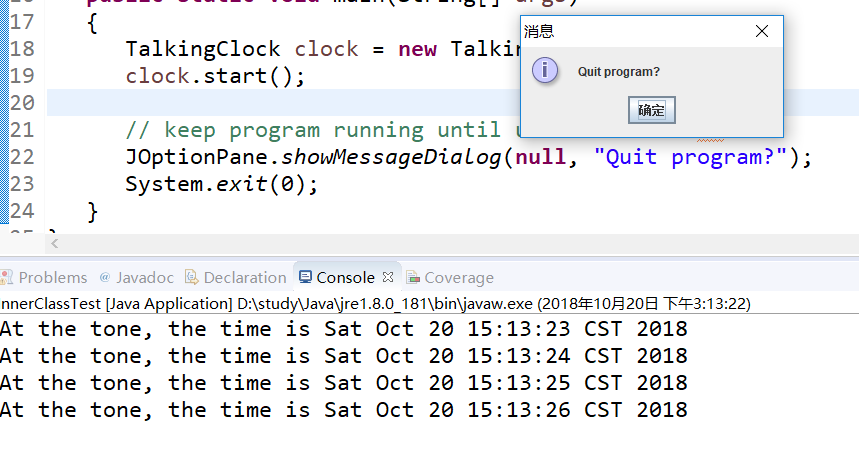
实验程序2:
1.编辑、调试运行教材254页程序6-8,结合程序运行结果理解程序;
2.了解匿名内部类的用法。
6-8程序如下:
package anonymousInnerClass; import java.awt.*;
import java.awt.event.*;
import java.util.*;
import javax.swing.*;
import javax.swing.Timer; /**
* This program demonstrates anonymous inner classes.
* @version 1.11 2015-05-12
* @author Cay Horstmann
*/
public class AnonymousInnerClassTest
{
public static void main(String[] args)
{
TalkingClock clock = new TalkingClock();
clock.start(1000, true); // keep program running until user selects "Ok"
JOptionPane.showMessageDialog(null, "Quit program?");
System.exit(0);
}
} /**
* A clock that prints the time in regular intervals.
*/
class TalkingClock
{
/**
* Starts the clock.
* @param interval the interval between messages (in milliseconds)
* @param beep true if the clock should beep
*/
public void start(int interval, boolean beep)
{
ActionListener listener = new ActionListener()
{
public void actionPerformed(ActionEvent event)
{
System.out.println("At the tone, the time is " + new Date());
if (beep) Toolkit.getDefaultToolkit().beep();
}
};
Timer t = new Timer(interval, listener);
t.start();
}
}
实验结果如下:
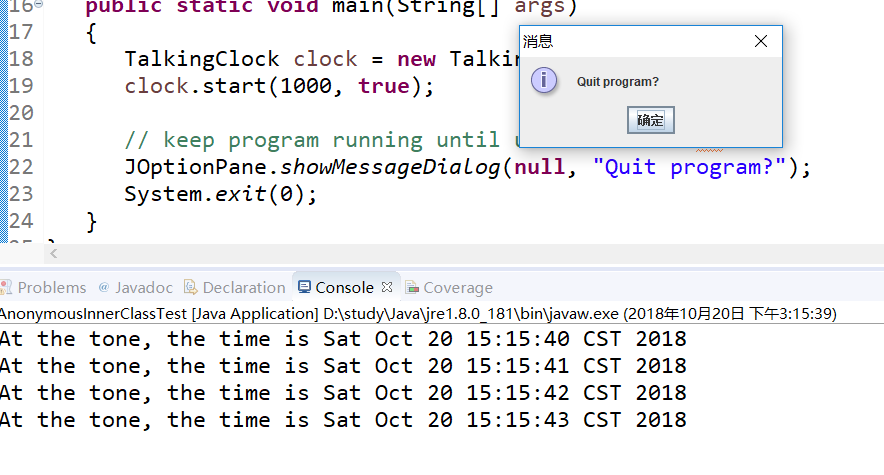
实验程序3:
1.在elipse IDE中调试运行教材257页-258页程序6-9,结合程序运行结果理解程序;
2.了解静态内部类的用法。
6-9程序如下:
package staticInnerClass; /**
* This program demonstrates the use of static inner classes.
* @version 1.02 2015-05-12
* @author Cay Horstmann
*/
public class StaticInnerClassTest
{
public static void main(String[] args)
{
double[] d = new double[20];
for (int i = 0; i < d.length; i++)
d[i] = 100 * Math.random();
ArrayAlg.Pair p = ArrayAlg.minmax(d);
System.out.println("min = " + p.getFirst());
System.out.println("max = " + p.getSecond());
}
} class ArrayAlg
{
/**
* A pair of floating-point numbers
*/
public static class Pair
{
private double first;
private double second; /**
* Constructs a pair from two floating-point numbers
* @param f the first number
* @param s the second number
*/
public Pair(double f, double s)
{
first = f;
second = s;
} /**
* Returns the first number of the pair
* @return the first number
*/
public double getFirst()
{
return first;
} /**
* Returns the second number of the pair
* @return the second number
*/
public double getSecond()
{
return second;
}
} /**
* Computes both the minimum and the maximum of an array
* @param values an array of floating-point numbers
* @return a pair whose first element is the minimum and whose second element
* is the maximum
*/
public static Pair minmax(double[] values)
{
double min = Double.POSITIVE_INFINITY;
double max = Double.NEGATIVE_INFINITY;
for (double v : values)
{
if (min > v) min = v;
if (max < v) max = v;
}
return new Pair(min, max);
}
}
实验结果如下:

第三部分:总结
通过本周的学习我收益很多,比如,知道了接口和继承之间的区别,object类的clone方法等,并在助教学长的指导下改善了上周测试题中的不足。本周的实验主要还是以理解课本中的代码案例为主,老师为了节省我们的时间,自主完成实验也只是在以前实验的基础上添加了新的知识内容,在课后探讨学习中助教学长给我们详细讲解了不理解的地方,拓展了我们的视野,展示了Java做工程的强大能力。更加加深了我们对Java的学习兴趣。
王之泰201771010131《面向对象程序设计(java)》第八周学习总结的更多相关文章
- 201871010124 王生涛《面向对象程序设计JAVA》第一周学习总结
项目 内容 这个作业属于哪个课程 https://www.cnblogs.com/nwnu-daizh/ 这个作业的要求在哪里 https://edu.cnblogs.com/campus/xbsf/ ...
- 201771010134杨其菊《面向对象程序设计java》第九周学习总结
第九周学习总结 第一部分:理论知识 异常.断言和调试.日志 1.捕获 ...
- 201871010132-张潇潇《面向对象程序设计(java)》第一周学习总结
面向对象程序设计(Java) 博文正文开头 项目 内容 这个作业属于哪个课程 https://www.cnblogs.com/nwnu-daizh/ 这个作业的要求在哪里 https://www.cn ...
- 扎西平措 201571030332《面向对象程序设计 Java 》第一周学习总结
<面向对象程序设计(java)>第一周学习总结 正文开头: 项目 内容 这个作业属于哪个课程 https://www.cnblogs.com/nwnu-daizh/ 这个作业的要求在哪里 ...
- 杨其菊201771010134《面向对象程序设计Java》第二周学习总结
第三章 Java基本程序设计结构 第一部分:(理论知识部分) 本章主要学习:基本内容:数据类型:变量:运算符:类型转换,字符串,输入输出,控制流程,大数值以及数组. 1.基本概念: 1)标识符:由字母 ...
- 201871010115——马北《面向对象程序设计JAVA》第二周学习总结
项目 内容 这个作业属于哪个课程 https://www.cnblogs.com/nwnu-daizh/ 这个作业的要求在哪里 https://www.cnblogs.com/nwnu-daizh/p ...
- 201777010217-金云馨《面向对象程序设计(Java)》第二周学习总结
项目 内容 这个作业属于哪个课程 https://www.cnblogs.com/nwnu-daizh/ 这个作业的要求在哪里 https://www.cnblogs.com/nwnu-daizh/p ...
- 201871010132——张潇潇《面向对象程序设计JAVA》第二周学习总结
项目 内容 这个作业属于哪个课程 https://www.cnblogs.com/nwnu-daizh/ 这个作业的要求在哪里 https://www.cnblogs.com/nwnu-daizh/p ...
- 201771010123汪慧和《面向对象程序设计Java》第二周学习总结
一.理论知识部分 1.标识符由字母.下划线.美元符号和数字组成, 且第一个符号不能为数字.标识符可用作: 类名.变量名.方法名.数组名.文件名等.第二部分:理论知识学习部分 2.关键字就是Java语言 ...
- 20155321 2016-2017-2 《Java程序设计》第八周学习总结
20155321 2016-2017-2 <Java程序设计>第八周学习总结 教材学习内容总结 创建Logger对象 static Logger getLogger(String name ...
随机推荐
- JAVA课程课后作业之使用递归完成回文
一.思路 1.我的想法是利用数组的做法来进行,先是用scanner录入一个String类 2.然后就是将String转化成char数组 3.递归的就是第一个和最后一个对比,然后第一个加一,最后一个减一 ...
- python学习之旅(三)
Python基础知识(2):运算符 一.算术运算符 加 +,减 -,乘 *,除 /,幂 **,求余 %,取整 // 二.成员运算符 in,not in 判断一个字符是否在字符串中 name = &qu ...
- VM装mac10.9教程+报错信息解决办法
VM装mac10.9教程+报错信息解决办法 教程1: 教你在Vmware 10下安装苹果Mac10.9系统 地址:http://tieba.baidu.com/p/2847457021 教程2: VM ...
- Java Filter(拦截器)
多个Filter按照在配置文件中配置的filter顺序执行. 在web.xml文件中配置该Filter,使用init-param元素为该Filter配置参数,init-param可接受如下两个子元素: ...
- js之常见问题--for循环中为什么点击总是弹出最后一个i
首先看看点击不同li标签时,弹出li的索引值对应的结果 HTML: <ul> <li>0</li> <li>2</li> <li> ...
- CRM项目自定义的知识点
python manage.py shell #自动配置环境 a = models.CustomerInfo #实例对象可以a._meta # dir 可以查看字段方法 a._meta.app_lab ...
- linux 逆向映射机制浅析
2017-05-20 聚会回来一如既往的看了会羽毛球比赛,然后想到前几天和朋友讨论的逆向映射的问题,还是简要总结下,免得以后再忘记了!可是当我添加时间……这就有点尴尬了……520还在写技术博客…… 闲 ...
- 4、jeecg 笔记之 自定义显示按钮 (exp 属性)
1.需求 先看一下需求吧,我们希望 datagrid 操作栏中的按钮,可以根据条件进行动态显示. 2.实现 其实 jeecg 提供了一个属性 - exp ,通过该属性即可实现. <t:dgFun ...
- kafka8 编写简单消费者
1.eclipse运行消费者代码.代码如下 package cn.test.mykafka; import java.util.Arrays; import java.util.Properties; ...
- linux affinity
现在的CPU几乎都是多核,所以,分配给予进程相同数量的线程是合理的需求 但是,这些线程不一定就均匀跑在这些内核上 所以,我们要指派,“一个线程就运行在一个固定的CPU内核上” //test.c #de ...
